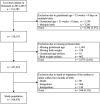Exclusive breastfeeding: Relation to gestational age, birth weight, and early neonatal ward admission. A nationwide cohort study of children born after 35 weeks of gestation
- PMID: 37224110
- PMCID: PMC10208505
- DOI: 10.1371/journal.pone.0285476
Exclusive breastfeeding: Relation to gestational age, birth weight, and early neonatal ward admission. A nationwide cohort study of children born after 35 weeks of gestation
Abstract
Objectives: Prematurity, being small for gestational age and early neonatal ward admission are the major neonatal conditions that may interfere with breastfeeding supportive practices in infants born at gestational age ≥35+0 weeks. We aimed to investigate the associations between gestational age, small for gestational age, early neonatal ward admission and exclusive breastfeeding at one and four months.
Methods: A register-based cohort-study of all Danish singletons with gestational age ≥35+0 weeks born in 2014-2015. In Denmark, health visitors routinely conduct free home visits throughout infants' first year and thereby report breastfeeding data to The Danish National Child Health Register. These data were linked with data from other national registers. Logistic regression models estimated the odds ratio for exclusive breastfeeding at one and four months, adjusted for confounding variables.
Results: The study population comprised 106,670 infants. Compared to gestational age 40 weeks, the adjusted odds ratio for exclusive breastfeeding at one month showed a decreasing tendency from gestational age ≥42 (n = 2,282) (1.07; 95% confidence interval (CI) 0.97-1.17) to 36 weeks (n = 2,062) (0.80; 95% CI 0.73-0.88). Small for gestational age (n = 2,342) was associated with decreased adjusted odds ratio for exclusive breastfeeding at one month (0.84; 95% CI 0.77-0.92). Neonatal ward admission was associated with increased adjusted odds ratio for exclusive breastfeeding at one month among late preterm infants (gestational age 35-36 weeks; n = 3,139) (1.31; 95% CI 1.12-1.54), as opposed to among early term (gestational age 37-38 weeks; n = 19,171) (0.84; 95% CI 0.77-0.92) and term infants (gestational age >38 weeks; n = 84,360) (0.89; 95% CI 0.83-0.94). The associations seemed to persist at four months.
Conclusions: Decreasing gestational age and small for gestational age were associated with decreased exclusive breastfeeding rates. Neonatal ward admission was associated with increased exclusive breastfeeding rates among late preterm infants, whereas the opposite was observed among early term and term infants.
Copyright: © 2023 Nejsum et al. This is an open access article distributed under the terms of the Creative Commons Attribution License, which permits unrestricted use, distribution, and reproduction in any medium, provided the original author and source are credited.
Conflict of interest statement
The authors have declared that no competing interests exist.
Figures
Similar articles
-
Breastfeeding outcomes in late preterm infants: A multi-centre prospective cohort study.PLoS One. 2022 Aug 15;17(8):e0272583. doi: 10.1371/journal.pone.0272583. eCollection 2022. PLoS One. 2022. PMID: 35969612 Free PMC article.
-
Factors associated with post NICU discharge exclusive breastfeeding rate and duration amongst first time mothers of preterm infants in Shanghai: a longitudinal cohort study.Int Breastfeed J. 2022 May 2;17(1):34. doi: 10.1186/s13006-022-00472-x. Int Breastfeed J. 2022. PMID: 35501877 Free PMC article.
-
Factors associated with exclusive breastfeeding of preterm infants. Results from a prospective national cohort study.PLoS One. 2014 Feb 19;9(2):e89077. doi: 10.1371/journal.pone.0089077. eCollection 2014. PLoS One. 2014. PMID: 24586513 Free PMC article.
-
Nutrition, growth, and allergic diseases among very preterm infants after hospital discharge.Dan Med J. 2013 Feb;60(2):B4588. Dan Med J. 2013. PMID: 23461996 Review.
-
The paradox of breastfeeding-associated morbidity among late preterm infants.J Obstet Gynecol Neonatal Nurs. 2011 Jan-Feb;40(1):9-24. doi: 10.1111/j.1552-6909.2010.01211.x. J Obstet Gynecol Neonatal Nurs. 2011. PMID: 21244492 Free PMC article. Review.
Cited by
-
Evaluation of the Impact of a Midwife-Led Breastfeeding Group Intervention on Prevention of Postpartum Depression: A Multicentre Randomised Clinical Trial.Nutrients. 2024 Jan 10;16(2):227. doi: 10.3390/nu16020227. Nutrients. 2024. PMID: 38257120 Free PMC article. Clinical Trial.
-
Trajectory of breastfeeding among Chinese women and risk prediction models based on machine learning: a cohort study.BMC Pregnancy Childbirth. 2024 Dec 24;24(1):858. doi: 10.1186/s12884-024-07010-z. BMC Pregnancy Childbirth. 2024. PMID: 39719546 Free PMC article.
-
Predicting early cessation of exclusive breastfeeding using machine learning techniques.PLoS One. 2025 Jan 9;20(1):e0312238. doi: 10.1371/journal.pone.0312238. eCollection 2025. PLoS One. 2025. PMID: 39787191 Free PMC article.
-
Process evaluation of a breastfeeding support intervention to promote exclusive breastfeeding and reduce social inequity: a mixed-methods study in a cluster-randomised trial.Int J Equity Health. 2024 Oct 8;23(1):204. doi: 10.1186/s12939-024-02295-0. Int J Equity Health. 2024. PMID: 39380053 Free PMC article. Clinical Trial.
-
Breastfeeding trajectory of mothers of preterm infants within 6 months postpartum: A longitudinal study.Int J Nurs Stud Adv. 2025 Feb 11;8:100311. doi: 10.1016/j.ijnsa.2025.100311. eCollection 2025 Jun. Int J Nurs Stud Adv. 2025. PMID: 40046823 Free PMC article.
References
-
- World Health Organization. Breastfeeding 2023 [cited 2023 January, 14 2023]. https://www.who.int/health-topics/breastfeeding#tab=tab_2.
-
- Regionernes kliniske kvalitetsudviklingsprogram. Dansk Kvalitetsdatabase for Nyfødte: Årsrapport 2020. 2021.
-
- Sundhedsdatastyrelsen. Indlæggelser af nyfødte [January 14, 2023]. June 28, 2019:[https://www.esundhed.dk/Emner/Graviditet-foedsler-og-boern/Indlaeggelser....



